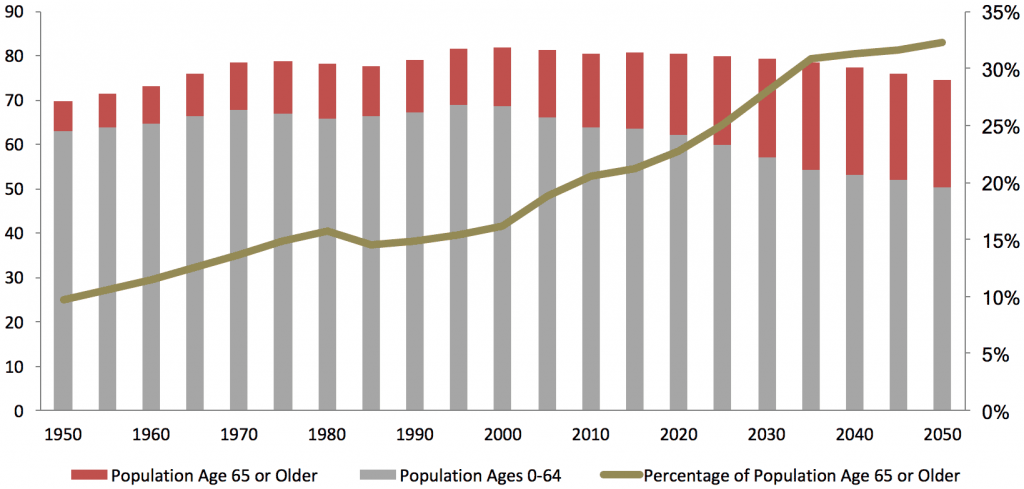
Around the world, populations are aging at an unprecedented rate. Improvements in healthcare, nutrition, and living conditions have extended life expectancy, while birth rates have plummeted in many developed nations. This demographic shift is creating a new global reality where countries face a growing proportion of elderly citizens. Among them, Japan, Monaco, Italy, Germany, and Spain lead the way, each navigating unique challenges and opportunities.
The Top 5 “Oldest” Countries
Japan: The Land of Longevity
Japan boasts an aging population like no other, with 28.2% of its citizens aged 65 and older. That’s over 36 million people. While it’s a testament to their healthcare system and lifestyle, it comes at a cost. Japan’s fertility rate hit a historic low of 1.26 in 2022, far below the replacement rate of 2.1.

Combined with a world-leading life expectancy of 85 years, Japan’s workforce is shrinking, leading to slower economic growth and rising public debtWorld Excellence InternationalMadison Trust Company.Despite these challenges, Japan is embracing innovation. Initiatives such as robotics in caregiving and policies to encourage women’s workforce participation aim to mitigate the economic impact of an aging society.
Monaco: A Mediterranean Oasis with a Silver Lining
Monaco, a tiny but affluent country, has a median age of 52, with a quarter of its population over 65. The nation’s wealth and robust social services help its aging population live comfortably. Yet, policymakers are exploring ways to balance the economic strain of an older population with opportunities for growth, including investments in youth education and workforce development.
Italy: Tradition Meets Decline
With 23% of its population over 65, Italy faces a dual challenge: a low birth rate and significant emigration of young workers. Many young Italians leave in search of better opportunities, further compounding the issue. In response, the government is offering financial incentives to families, such as tax breaks and childcare subsidies, to encourage higher birth rates and attract foreign workers.
Germany: The Technological Pioneer
Germany, where 21% of the population is over 65, is turning to technology to tackle its demographic challenges. E-health initiatives and digital tools help older citizens maintain independence and access healthcare efficiently. Additionally, Germany is focused on upskilling older workers and incorporating automation to sustain its industrial output.

Spain: A Long Life, But at What Cost?
In Spain, 20% of the population is aged 65 or older, with an average life expectancy of 83.6 years. However, Spain’s aging trend coincides with a declining population due to economic migration during the 2012 financial crisis. To reverse the trend, the government is prioritizing family-friendly policies and investments in social services.
The Economic Ripple Effects of Aging Populations
An aging society creates a cascade of economic challenges:
- Shrinking Workforce: Fewer working-age people mean labor shortages, slower economic growth, and reduced tax revenue to fund pensions and healthcare.
- Healthcare and Social Costs: With age comes increased demand for healthcare and social services, straining public budgets and potentially leading to higher taxes.
- Innovation Opportunities: Aging populations also drive innovation, such as advancements in robotics, AI, and healthcare technologies tailored to seniors.
Countries on the Verge of Aging
Countries like South Korea and some in Eastern Europe are approaching similar demographic tipping points. South Korea, for instance, is projected to have the world’s oldest population by 2070, with only one worker for every retired person. To counteract this, policies are being enacted to encourage higher birth rates, such as subsidizing childcare and increasing immigration.
How to Prevent the Challenges of Aging Populations
Governments can take proactive measures to manage aging populations effectively:
- Encourage Higher Birth Rates: Financial incentives, tax benefits, and robust parental leave policies can help.
- Promote Immigration: Welcoming skilled immigrants can replenish workforces and stimulate economic growth.

- Invest in Technology: Countries like Japan and Germany demonstrate how automation and AI can address labor shortages while improving the quality of life for seniors.
- Enhance Workforce Participation: Encouraging women and older adults to stay in or rejoin the workforce boosts productivityWorld Population ReviewMadison Trust Company.
A Future Reimagined
While aging populations undeniably present challenges, they also inspire innovation and transformation. By embracing technology, crafting inclusive policies, and fostering collaboration between generations, nations have a unique opportunity to rewrite the narrative of aging. Instead of viewing it as a crisis, we can frame it as a chance to build societies that value resilience, equity, and the contributions of all ages. The age of longevity might just become the age of reinvention.














